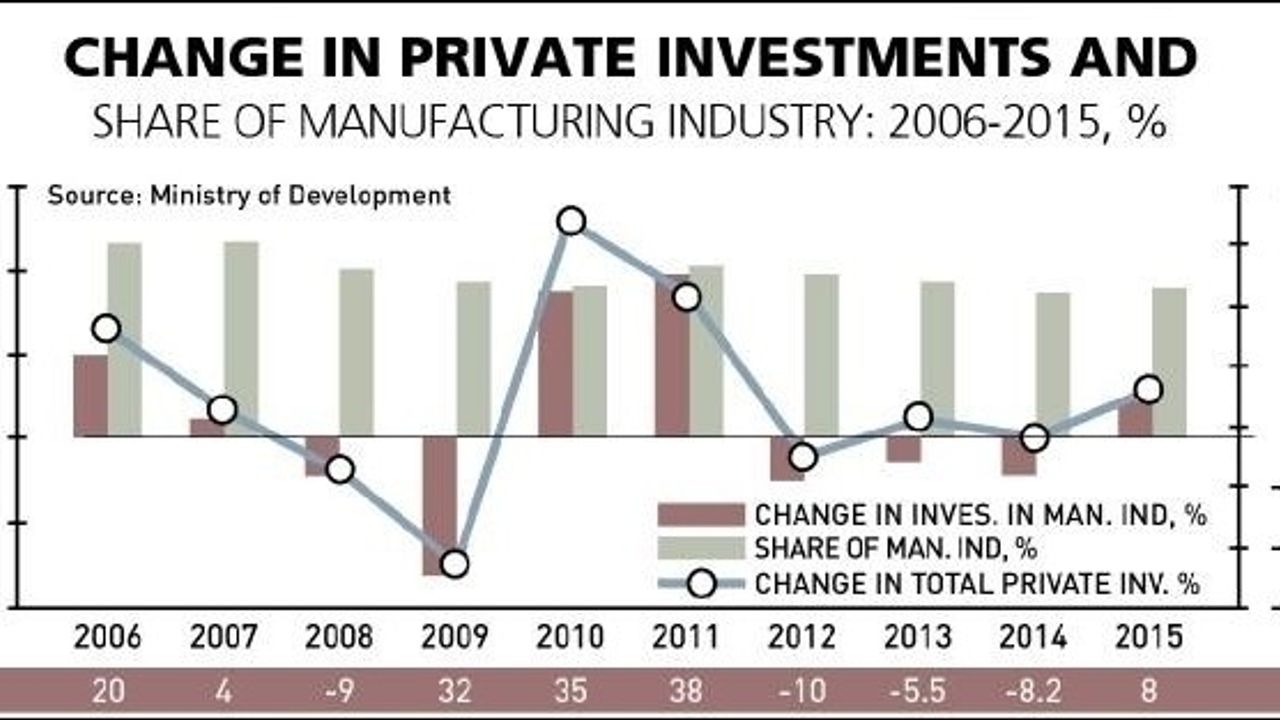INDUSTRIAL INVESTMENTS CONTINUE to STAGNATE
The loss of appetite in the Turkish economy since 2012 continues to be a problem, even if there was a slight recovery in 2015. The slippage especially in industrial investments is remarkable and, simultaneously, a warning.
Why is industry more important? The reason is that the share of industry in gross domestic product is relatively small at 16 percent but industry constitutes the bulk of exports. The intermediate goods in imports and investment goods are also linked to industrial production. Thus, all the service sectors associated with foreign trade feed on industry. In short, because the manufacturing industry is a sector that has a small share in production but a big role in sustainability, the decline of investments in this sector means a decline in the economy, according to an analysis from Mustafa Sönmez, published on Hürriyet Daily News.
Data on 2015 national income that was released at the end of March shows that the contribution of investments in growth that was declared as 4 percent was nearer to one fourth of this figure. In other words, in the growth of 4 points, the contribution of investments was around 1 point (0.9). 2015 was comforting because in 2014, the contribution of investments in the 2014 growth figures of 3 percent was negative. In 2013, just like in 2015, it was around one-fourth.
In 2012, it was again negative. Overcoming a period in which growth is unable to take advantage of investments, especially when industry investments slip, and reaccelerating again remain two of the most important issues for Turkey’s economy.
The 2012-2015 period can be described as the “low growth” period. In this period, while growth fell to the 3 to 4 percent band, the situation was created because of a deceleration of investments. In these four years, private-sector investments particularly fell concretely, but in 2015, there was a slight recovery.
In the 2012-2015 period, the average growth was 3.5 percent. It can be seen that the contribution of investments in this period fell to 5 percent. In other words, the contribution from investments to the 3.5 percent growth in this period remained at 0.3 points. Turkey is passing through a period in which investments have fallen considerably compared to previous years.
Stagnation in industry investments The issue of a slowdown in investments, particularly in the manufacturing industry, has caused more damage. This is because, as said before, the manufacturing industry is a leader. While industry constitutes the body of exports, the intermediate goods and investment goods of imports also depend on industrial production. Thus, all service sectors associated with foreign trade are also nurtured in industry. In short, even though the manufacturing industry has around a 15 percent share in production, because it is a sector that has a huge leading role, any stagnation in this sector actually entails a stagnation in the economy. When the share of sectors in investments between 2006 and 2015 is examined, it can be seen that the share of the manufacturing industry dropped 6 points from 35 to 29 percent. This drop is mostly due to the private sector refraining from investing in the manufacturing sector.
In the same period, there have been increases in the shares of tourism, mining, education and transportation while the share of the other notable investment field, the housing sector, remained at a band of 14 percent and 15 percent. The decline in investments in past years stems from the lack of appetite mostly in manufacturing sector investments rather than the lack of appetite of the private sector.
According to Development Ministry data, in private investments, the share of the manufacturing sector in 2006 was 46 percent. In the following years, both the rate of private sector investments to national income declined, as did the share of the manufacturing industry in private investments. In other words, the lack of appetite in investments in the manufacturing sector caused a fall in all private-sector investments. Total private sector investments declined in real terms in the period between 2012 and 2014, but increased by 6 percent in 2015.
While private-sector investments declined in general, the share of manufacturing in 2006 was 46 percent, which then decreased 10 points to 35 percent, the average of the 2012-2015 period. Incentives The stagnation of investments in industry can also be observed through the incentives issued regarding the quantity and composition of investments.
The incentive system was explained in the 2016 program:
“It is the main aim to increase private-sector investments that are necessary for a high growth, by making the investment environment more attractive and encouraging investments. The aim of the practice is [to ensure] investments with added value and a high R&D content, increase employment, exports and production, improve international competitive power and enable the regional potentials to join the economy.”
In this context, the balance sheets of the past three years of investment incentives demonstrate the lack of appetite once more in the investment in the manufacturing industry. While incentives were issued for investments worth 96 billion Turkish Liras in 2013, this dropped to 64 billion liras in 2014 before rising to 103 billion liras the following year. The recovery in 2015 is noteworthy; however, when analyzed closely, this increase in the amount of investments was due to one incentive issued to TANAP Doğalgaz İletim A.Ş. worth 23.2 billion liras.
When the sector breakdown of investments are reviewed, it can be seen that only one third of the supported investments of 264 billion liras at current prices in the 2013-2015 period belongs to the manufacturing industry. Services and energy investments seem to have taken similar shares with the manufacturing industry. The intentions to invest in the manufacturing industry were worth 36 billion liras in 2013 but declined to 25 billion liras each in 2014 and 2015. This is another indicator of the lack of appetite related to manufacturing. The investment environment If the public sector is excluded, it is up to the political and geopolitical risks as well as the economic risks that determine the investments decisions of both local and international private actors.
The international hot money that started withdrawing in mid-2013 with the American Central Bank Fed’s rate hike signal that has rapidly increased the dollar/lira exchange rate made the investor enter a “wait and see” phase. When the increase in the dollar price was followed by the increase in interest rates, domestic consumption which is the main pillar of growth rapidly shrank. This was the most influential factor in the suspension of new investments, particularly investments in manufacturing industry. Besides economic fragility, the election calendar in Turkey, in which there were three elections in 2014 and 2015, has been another factor resulting in a suspension of investment intentions. In addition to these, the tensions in the Middle East and their ramifications in Turkey, the tensions experienced in neighboring countries have constantly postponed decisions for both domestic and international investors.
INDUSTRIAL INVESTMENTS CONTINUE to STAGNATE
The loss of appetite in the Turkish economy since 2012 continues to be a problem, even if there was a slight recovery in 2015...
Kaynak: Doğan Haber Ajansı
Yorumlar


